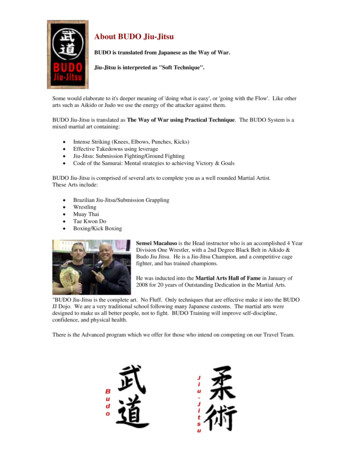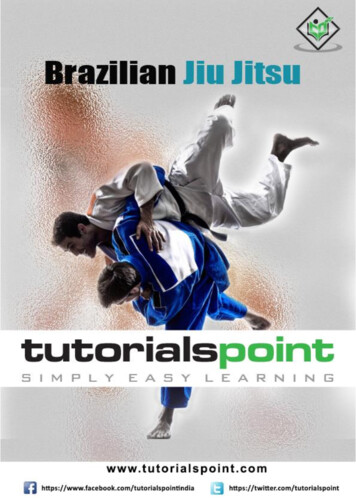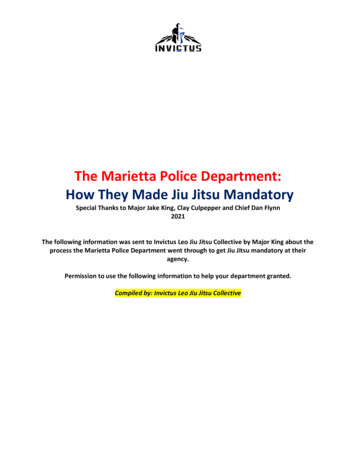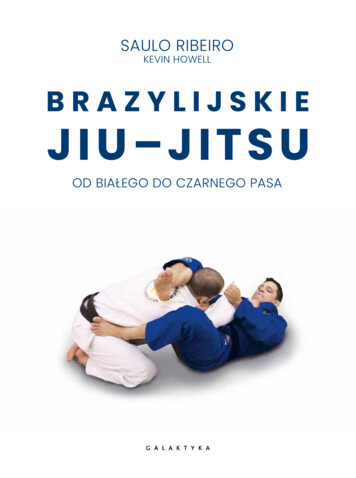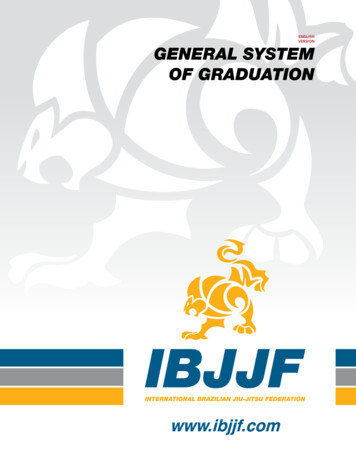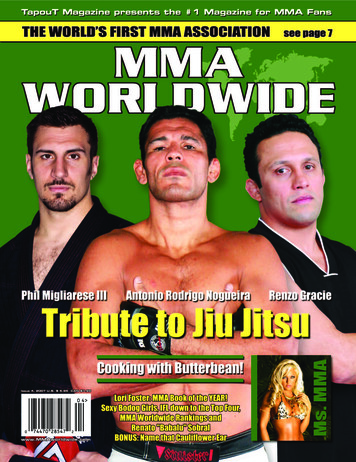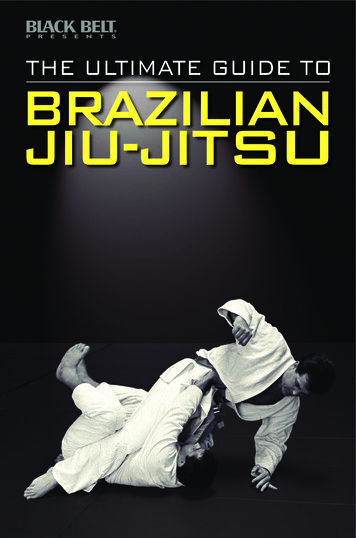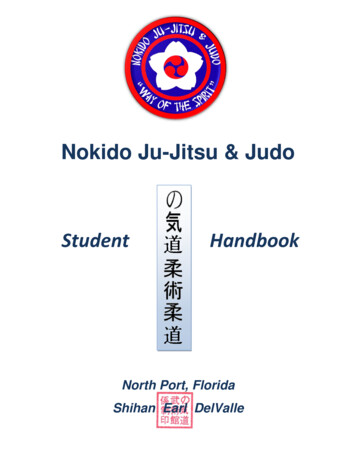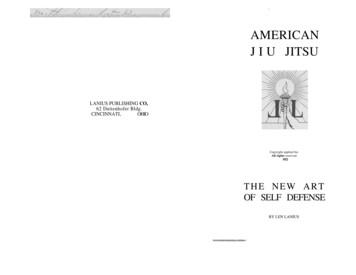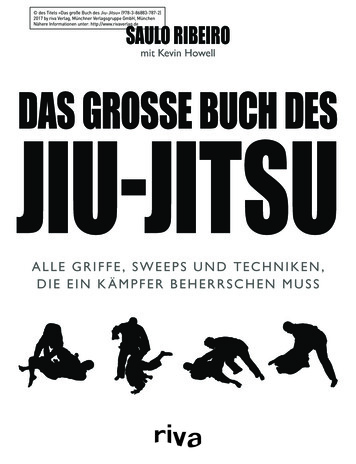
Transcription
JiuJitsuCompleteby KIYOSE NAKAEAssistedby CHARLES YEAGERtr!HMAN BROS.PUBLISHERS1118ROADW Y.NEWYORK3. N.Y.LYLESTUARTNEW YORK
Jiu Jitsu Complete@ 1958, byKiyose Nakae & Charles YeagerAll rights reserved including theright to reproduce this bookor portions thereof in any form.LIBRARY OF CONGREssCATALOG CARD NUMBER:58-10229Queries regarding the rights and permissionsshould be addressed to Lyle Stuart225 Lafayette Street, New York 12, N. Y.Designed by john PutnamTypography by The Polyglot PressPrinted in the United States of America
Publisher'sPrefaceI have known and admired Professor Kiyose N akae for manyyears. He is considered the foremost instructor of authentic Jiu Jitsuin the western world. His students come from all over the world toNew York City. To receive private lessons from him you have to putyourself on a waiting list and his schedule is so crowded that you mayhave to wait a year or two for your first lesson.Professor Nakae has spent most of his life teaching Jiu Jitsu toAmericans. When he first arrived in this country some fifty years agohe was hired to teach his skills to police departments in all parts ofthe land.Professor N akae knows thousands of tricks. From his boyhood hewas drilled in the methods of the old masters of the Jiu Jitsu art. Innearly fifty years of teaching, he has boiled his system down to a compact group of tricks which comprise a complete method of self-defenseand which are the easiest and most practical to learn. The dubioustricks that don't work-and which are found in so many of the booksthat have appeared on the subject-are not in these pages. The tricksin these pages work: each and everyone. This alone makes it a uniqueproduct!It is one thing to teach Jiu Jitsu in private lessons. It is quiteanother to teach it with a book. Only because of Nakae's deep understanding of his science and his unequalled teaching ability has such abook become possible.Books on the self-defense arts are usually illustrated with cartoonsor photographs. Professor Nakae and Charles Yeager examined theseand concluded they were of little value when it came to practicallearning.A new method of showing the tricks had to be devised. Hundredsof photographs were taken of two men in action. A skilled artist thenmade line drawings from the photographs. I believe the result has morethan justified the time, effort and expense that was invested to makesuch a perfect visual presentation.My feelings were confirmed when the manuscript of this book wassubmitted to B. Vedel of Chicago who is probably the authority onbooks about Jiu Jitsu and Judo."The line drawings are a brilliant idea!" was the comment. "Thisis the best thing I have ever seen on the subject, and as you know, Iregard books on the subject with a very jaundiced eye. This one isalmost as good as actually working in class!"There has never been a book like this one. And perhaps there hasnever been a time when this book was so badly needed. For in thischanging world, the streets of our cities often seem like paths in a densejungle fraught with peril.3
A working knowledge of Jiu Jitsu offers the average man (orwoman) an ability to cope with and triumph over a physical attacker-and to do so with ease. This, whether the opponent is larger, morepowerful, or armed with knife or gun.Mastering Jiu Jitsu has the pleasant byproduct of giving one afeeling of security in situations once packed with tensions and fears.Interestingly enough, a study has shown that a person trained in JiuJitsu is less likely to run into "trouble" than an untrained person. Thiscould be because of the air of self-confidence the Jiu Jitsu-trainedperson possesses. Or it may be because he is less willing to become embroiled in physical violence because he knows that when he goes intoaction, the other guy is going to be badly hurt. Theodore Rooseveltsaid to "Speak softly and carry a big stick." The Jiu Jitsu student mayalso speak softly because he knows that his skill is a very big and verydamaging stick.The book you hold in your hands is not a plaything. Jiu Jitsu isserious business and must be studied and practiced until the studentis skilled in the art.I was tempted to say "in the almost lost art" for a lost art it hasalmost become. Jiu Jitsu is no longer taught in Japan. It is no longerpassed from generation to generation, as it had been for hundreds ofyears. And here I should explain that Jiu Jitsu is not Judo-andthetwo should not be confused.Judo is a sport and a worthy one. Its popularity is very much onthe increase, and many believe the time will soon come when Judo isan Olympics sport.There is a surface similarity about some of the movements in Judoand Jiu Jitsu-butthere the likeness ends. Judo, of course, derivedmuch from Jiu Jitsu.However Jiu Jitsu is an art of self-defense which was developedwith skill and precision as the exclusive property of Japanese nobility.Judo is played for points. Jiu Jitsu is played "for keeps." WithJiu Jitsu you may, as you desire, punish, damage, or even kill youropponent.With Jiu Jitsu, David may defeat Goliath. Thus the beaury of theart is that it relies for success not upon brute strength but upon finesseand the ability to win by seeming to yield.One last note before you enter the portals of your Jiu Jitsu classroom. As the published, it was my original plan to price this book at 6. Though the volume is small, its production costs were large andwould justify the 6 price. But then it was decided, for sentimentalreasons, to price the book at 5. For 5 is the cost of a single forty-fiveminute lesson with Professor Nakae. And here is the course for theprice of a single lesson!Lyle Stuart4.
Tothe generations of men before uswhose lifetime devotion to theart of ]iu ]itsu has made thisbook possible.
FOREWORDJiu Jitsu is a method of defense and offense without weapons inpersonal encounter. For many centuries in Japan it was practiced asa military art, together with fencing, archery and the use of the spear.Jiu Jitsu is not a contest of muscular strength. Nor is its primepurpose to maim or kill, but merely to incapacitate one's opponentfor the time being by means of simple tricks and holds.Jiu Jitsu tricks and holds are very simple. A thorough knowledgeof them, gained only with constant practice, should develop in one afeeling of strong self-confidence. This confidence causes the Jiu Jitsuexpert to react almost instinctively in the event of a sudden attack andto maneuver any situation to his own advantage.Professor K. Nakae is one of the few living masters of authenticJiu Jitsu. As Chief Instructor of New York's Dojo (Judo academy) Ihave seen many books written on this subject. This book is unusuallygood for the simple and clear illustrations and captions are readilyunderstood by the beginner. And they derive from genuine knowledgeand skill.George G. Yoshida7
1. The BeginningYou are about to take an intelligent and progressive step whichshould provide mental and physical benefits for you not only in theimmediate future but for the rest of your life. You are about to begintraining in Jiu Jitsu.Jiu Jitsu tends to wipe out the differences of size, weight, heightand reach. The possesser of the skill gains tremendous self-confidenceand the ability to walk without fear.Skill and knowledge are in themselves sufficient to subdue anyaggressor no matter how strong or vicious. You are always ready foraction, unarmed, in any situation, regardless of the direction fromwhich the attack comes.The first lesson you must learn is poise and assurance. You learnto be mentally cool and alert in the face of danger, and you beginto experience a self-restraint which comes only with supreme selfconfidence.Jiu Jitsu Complete was written to fill the definite need at thisfor a more practical, a more complete and more authoritative courseon the subject ,han has heretofore appeared.Jiu Jitsu is a word which consists of two parts: jiu means "gentle,pliable, virtuous, to submit" and jitsu means "art or science." In meaning and in fact, Jiu Jitsu depends not on brute strength but on psychology, knowledge of anatomy, and skill that comes from practice inmaking certain movements with your body.Practice-andlots of it-is essential. To become an expert in thecomplete art requires years of training. However a few simple trickswhich may be adapted to any emergency are enough to put mastery inthe hands of the average person who must defend himself against anassailant who has superior strength or who may be armed.Jiu Jitsu is not Judo. The tricks in this book are dangerous andmust be practiced with extreme care. In Judo, a modified derivation rem Jiu Jitsu, friends can compete because real danger-tricks havebeen removed and because certain rules and prohibitions are imposedin order to avoid injury to the participants. Not so with Jiu Jitsu. Jiu Jitsu is dangerousbusiness and shouldbe used only in case of emergency where "anything goes" for the sakeof self-protection.Strength is not a majqr factor in Jiu Jitsu. Rather, balance, leverage and speed are needed, for then available strength is applied to itsgreatest advantage.8J.
Women can become proficient in Jiu Jitsu. In many tricks, thestature of a woman, the softness of her arms and the sharpness of herheels are exceedingly potent weapons. Moreover, women need JiuJitsu. Many a girl owes her life to a slight acquaintance with its tricks.As sex is no barrier to learning, so age is no barrier. Newspapersrecently told of a 72-year-old frail man who, with Jiu Jitsu, disarmeda youthful robber who was forty pounds heavier than he. The old manheld him with ease until the police arrived.Even the police often have a need for Jiu Jitsu. In my lifetime Ihave demonstrated and proven the superiority of this science to policedepartments in Yonkers, Chicago, Philadelphia, Pittsburgh, Detroit,Memphis, Syracuse, Toledo, Montreal and Indianapolis.Many police officers have enrolled with me for private lessons.I hope you will never be in a position where your life is endangered. But if it is, I am confident that what follows will prove ofvalue to you-if you learn it.Good things take time. Do not hurry through this book. Practiceeach trick diligently until you know it well.As you learn new tricks, keep practicing the old ones. This reviewand practice is important. Especially since I am going to give you themost difficult tricks first. Only practice, practice and more practice willgive you proficiency in Jiu Jitsu.Let us begin then by acquainting you with a classification of JiuJitsu's tricks.There are the exercises and the break-falls.There are throws and holds and combination tricks. There arebreaking tricks. And there are practical applications of Jiu Jitsu suchas the defense against a knife or a club or a gurf or a blow with a fist.For the complete list of the tricks we are going to learn, turn thepage. As you become good in the application of a trick, check it off.You will be pleased to discover how quickly they come to you onceyou have mastered the first few.Now, with a minimum of further talk, we shall get to the exerCIses.You will find that the instructions which accompany each illustration are brief and to the point. Read them carefully. No words havebeen wasted-and every word is meaningful if you are to progress asyou should.9
Although a gym (wrestling) mat is not essential-it is quite helpful. If the use of one is not available to you, a thick rug or any surfacesofter than cement or hard earth would be helpful for learning andpracticing. In place of carpeted floors, a soft lawn or a sandy beach issuitable.When practicing the tricks which follow, dress in old clothes orshorts. Your clothing should be loose enough to permit free comfortable movement.10
-CLASSIFICATIONOF TRICKSEXERCISES. . . . . . . . . . . . . . . . . . . . . . . . . . . . . . . . . . . . . . . . . . . . . . . . . . . . . . 14BREAKFALLS. . . . . 161. THROWSa. Foot Technique"Spooning"AnkleThrowNo.1. . . . . . . . . . . . . . . . . . . . . . . . . . . . . . . .32"Spooning"AnkleThrowNo.2. . . . . . . . . . . . . . . . . . . . . . . . . . . . . . . 34"Spoonin!?;"AnkleThrowNo.3. . . . . . . . . . . . . . . . . . . . . . . . . . . . . . 35Sweeping CalfNo.1. . . . . . . . . . . . . . . . . . . . . . . . . . . . . . . . . . . . . . .26The KneeWhirl. . . . . . . . . . . . . . . . . . . . . . . . . . . . . . . . . . . . . . . . . . 43Scissor. . . . . . . . . . . . . . . . . . . . . . .28Sweeping Calf No.2withShoulderb. Hip TechniqueSpring Hip Throw40Sweeping-SideHip Throw. . . . . . . . . . . . . . . . . . . . . . . . . . . . . . . . . . . .58c. Hand TechniqueOver-Shoulder Throw. . . . . . . . . . . . . . . . . . . . . . . . . . . . . . . . . . . . . . . 44HandThrowNo.1. . . . . . . . . . . . . . . . . . . . . . . . . . . . . . . . . . . . . . . . 98HandThrowNo.2. . . . . . . . . . . . . . . . . . . . . . . . . . . . . . . . . . . . . . . 102HandThrowNo.3--Spinner. . . . . . . . . . . . . . . . . . . . . . . . . . . . . . 104HandThrowNo.4-ArmPressureAgainstKnee. . . . . . . . . . . . . . . . . . 622. HOLDSa. Against the JointsShoulder Lock. . . . . . . . . . . . . . . . . . . . . . . . . . . . . . . . . . . . . . . . . . . . 64ElbowLock(Down)No.1. . . . . . . . . . . . . . . . . . . . . . . . . . . . . . . . . . . 64, . . . . . . . . . . . . . . . . . . . . . . . . . . . . . . . . . . . . . . . . . 78ArmLockNo.1. . . . . . . . . . . . . . . . . . . . . . . . . . . . . . . . . . . . . . .'. . . 120Elbow Lock (Up)After Breaking;When Opponent Holds ArmAfter Breaking, When Opponent Holds from Front (1)After Breaking, When Opponent Holds from Front (2)Bent-ArmWristLock. . . . . . . . . . . . . . . . . . . . . . . . . . . . . . . . . . . . . . .66Straight-Arm Wrist Lock79b. Against NervesPencil Holding Trick. . . . . . . . . . . . . . . . . . . . . . . . . . . . . . . . . . . . . . . 22FingerHoldingTrick. . . . . . . . . . . . . . . . . . . . . . . . . . . . . . . . . . . . . . .82c. Neck HoldsStrangleHoldNo.1 (FromRear). . . . . . . . . . . . . . . . . . . . . . . . . . . . . .84StrangleHoldNo.2(FromFront). . . . . . . . . . . . . . . . . . . . . . . . . . . .883. COMBINATIONTRICKSEffectivecombinationsof foregoingtrick ElbowLock (Down)to SweepingCalf No.1. . . . . . . . . . . . . . . . . . . . . . . 138HandThrowNo.2to StrangleHold. . . . . . . . . . . . . . . . . . . . . . . . . . . .136HandThrowNo.1to HandThrowNo.4(AgainstKnee). . . . . . . . . . . .136HandThrowNo.1toHipThrow. . . . . . . . . . . . . . . . . . . . : . . . . 157SpringHip Throwto Sweeping-SideHip Throw. . . . . . . . . . . . . . . . . . 74ElbowLock(Up) to SweepingCalf No.2. . . . . . . . . . . . . . . . . . . . . . . . . .138And many others11
4. BREAKING. TRICKSHow to free yourself from strangle and other holds. . .When Opponent Strangles from Rear (I).50When Opponent Strangles from Rear (2) . . . . . . . . . . . . . . . . . . . . . . . . . . . . . 51When Opponent Strangles from Front (I)19When Opponent Strangles from Front (2)20When Opponent Strangles from Front (3)42When Opponent Holds from Front. . . . . . . . . . . . . . . . . . . . . . . . . . . . . . . . . 26When Opponent Holds from RearWhen Opponent Hugs Tightly114. . . . . . . . . . . . . . . . . . . . . . . . . . . . . . . . . . . . 60When Opponent Hugs from Rear, Over Arms. . . . . . . . . . . . . . . . . . . . . . . . . .128WhenOpponentHugsfromRear, UnderneathArms. . . . . . . . . . . . . . . . . . . . 21" . . . . . . . . . . . . . . . . . . . . . . . . . . . . . . . . . . . . . . . 90Breaking Half-NelsonBreaking Full-Nelson . . . . . . . . . . . . . . . . . . . . . . . . . . . . . . . . . . . . . . . . . . . 92When Opponent Holds Arms from Front (I). . . . . . . . . . . . . . . . . . . . . . . . . . . 128When Opponent Holds Arms from Front (2). . . . . . . . . . . . . . . . . . . . . . .132WhenOpponentHoldsTwoHandsfromRear. . . . . . . . . . . . . . . . . . . . . . . . . 124s.PRACTICALAPPLICATIONa. DefenseAgainst Blowwith Fist. . . . . . . . . . . . . . . . . . . . . . . . . . . . . . . . . . . . . 84Practical means of avoiding blows from any directionand of throwing, and holding.b. DefenseAgainst Knife . . . . . . . . . . . . . . . . . . . . . . . . . . . . . . . . . . . . . . . . . . . 108Practical means of protecting yourself against anopponent armed with a knife, and of disarming,throwing or holding.c. Defenseagainst Club. . . . . . . . . . . . . . . . . . . . . . . . . . . . . . . . . . . . . . . . . . . . .115Practical means of protecting yourself against anopponent armed with a club, and of disarming,throwing or holding.d. Defense Against Pistol. . . . . . . . . . . . . . . . . . . . . . . . . . . . . . . . . . . . . . . . . . . 140Practical means of protecting yourself against anopponent armed with a pistol (and within reach),and of disarming, throwing or holding.6. ARTS FOR EMERGENCIESResuscitation. . . . . . . . . . . . . . . . . . . . . . . . . . . . . . . . . . . . . . . . . . . . . . . . . . 162The lessons in this course are not furnished you inexactly this order since it is frequently more interesting for the student to learn as he progresses,how throws may be combined with blows, etc. However when you have learned all the lessons in thisbook, you may wish to practice them in this order asa logical system.12
IiI13
r EXERCISESPURPOSE: To train the muscles to extendand contract freely, and the joints to function smoothly in every part of the body.ABA.-Lift arms, extend forward and pullback in loose flowing motion, the fingersopening and closing alternately. Do this 6times. Then extend the arms over the headand back to the shoulder in the same manner for 6 times.B.-Extend arms forward, move them inlarge circles, the right ann clockwise, theleft counter clockwise, do this 6 times thenreverse.cC.-Place your left palm on your left hip,with fingers pointing to the floor. Pushbody forward and to the side, straightenup and repeat with right hand. Alternate6 times.14DD.-Stand on left foot and move your rightfoot in the air in circles. This exercises thehip joint. Lift the right heel to the buttockand down again, this exercises the kneeand ankle joints. Repeat with the left. Thisis good practice for balancing on one foot,which, as you shall see, is important.a
EE.-Half raise arms and lean back, thenlean forward, bending knees, and touch thefloor with your nands.NOTES.-Remember, these exercises are forflexibility and not for strength. They mustbe done slowly, with body held loosely. Themuscles and joints must never be tightened.15.
BreakFall No.1FALLING BACKWARD SITTING POSTURE# # BA .#,f I Raise both arms, cross at the wrist andbring to shoulder height. (I)NOTE;-As you roll back, pull your chinto your chest and watch your belt. Thisprotects your head from hitting the mator ground. Falling back should be likerolling a wheel, the feet raising automatically. The hands hit when shoulder bladesRoll backward, raise both feet together (2).Hit mat with both hands (3).touch the mat. Fingers held straight together (lightly), hitting with the wholearm. This BREAKS the fall. Kick up withboth legs at moment of hitting. This stopsyou from rolling over.BreakFallNo.2FALLING FORWARDA,/B"G ##"!- cv Raise arms as in "B" (I). Raise heels andbendle s (2).16 Kneel on mat, continue forward motionof body and land on arms from fingertipsto elbows (3) arms extended in directionof body.
FALLING BACKWARD STANDING POSTUREIreak Fall No. 3Raise your arms as in "B" (1). Bend legsat the knees (2).'eakFall No. 4,Raise one leg (3).FORWARD SOMERSAULTB) forward a little outside with right.cB(1) bent forward, place left hand onmd palm down (2).ahead of left foot.right hand on ground pa-lm up (3)veen left hand and left foot.lEAKFALL No.4. (C) After practisingwhile you will find that there are differt ways of finishing.(1) One leg in the air(2) Both legs in the air(3) Halfway getting up(4) Getting UpRepeafoot onthe low(7), hit Jis keptiPush your body forward,throw up left leg, turnbody over as in "B."cRepeat Afall "G," 1leg lies 0remainirfFinish as in "C.".
WARD STANDING POSTUREcDE1Raise one leg (3).Lower body near the ground (4).Finish as in "E" by raising legs (5) andhitting mat (6)."ERSAULTFRepeat A B. C. D. and finish with onefoot on ground, raise the body to keep upthe lower back to avoid injury (kidney)(7), hit mat with both hands (8) other f9Qtis kept in air (9).r body forward,Other way.p left leg, turnIVer as in "B."\Repeat A. B. C. D. and finish with sidefall "G," hit mat with one hand (10). Oneleg lies on mat (II) other arm and legremain free (12 and 13).h as in "C."u
Breaking - Opponent Strangles from FrontBAIf opponentattemptshands from side.to stranglewith twocDSwing your hands up between opponent'sarms (2).Put your hands together (1).In this situation, opponent's weak spot ishis elbow. The idea is to apply pressureThe impact of your arms against the insideof his arms will break the hold.with your arms against his elbows Now trythe next trick, which is just as easy.19
Breaking-Opponent Strangles from FrontAIf opponent attempts to strangle you withone hand back of your neck, one hand infront of neck, and his head in close; orboth hands choking from side; or in anycase in which opponent holds you with hisface in close . .'.This will put you in the position shownabove. Opponent will cry, temporarilyblinding himself. You will be free and ableto start almost any of the throws or finishing tricks to be described later.20Frequently, when an opponent attemptsto choke, or in any case when he holdsyou from the front, a strong blow to thenose with the base of the hand is all thatis needed to break the hold.Smear his nose up and backwith either hand.Remember that when you have finishedeither this or the previous trick, you havemerely freed yourself. But this is notenough. You must either hold opponentin a helpless position or must apply punishment if you really mean to protect yourself.Many different ways to hold- or punishan opponent will be taught you in thiscourse. But because there are so manytricks, you may be tempted to ask, "Whyare they all needed?" No matter how gooda medicine is, it is not good for every case.Therefore, it is wise to have many kindsof medicine available, so that if one doesnot work, another may be tried.Likewise, there are many different partsof the body which can work together orindividually. The knowledge of manytricks will enable you to protect yourselfeven if both hands are incapacitated-byusing the feet. Or if your feet are held-byusing your hands. Or you may find yourselfseated when the attack comes.When you have finished this course youwill be master of many tricks, and will beable to protect yourself regardless of yourposition when danger comes.
tSreaking-Opponent Hugs from Rear, Underneath ArmsIf opponentattempts to hug you tightlyfrom rear, underneath arms .Drop hips, bend over and seize opponent'sright leg with both hands (3). Now lift hisright leg quickly (4) with your hands whilepressing down against his right leg withthe back side of your left thigh.VARIATIONSIf your opponent holds you with one handunderneath your arm, and the other handover your shoulder and mouth,. you canfree yourself by a blow from your elbowto his neck.If opponent holds as shown in "A," youcan also free yourself by a blow with elbowto his chin. If blow is hard enough, it will.LTake a long step to the right with yourright foot (1) so that opponent's right kneeis behind your left thigh. Bend forwardand prepare to seize opponent's right leg(2). (If opponent holds very tightly, pushagainst his stomach sharply with your hips.)This will force your opponent to fall.knock opponent out.Or if opponentholds as in "A," you canalso free yourself by a sharp blow with theback of your head to his chin. If opponentis too short for a blow to his chin, thesame blow against his nose or forehead willbe equally effective.Or you can free yourself by a back:kickto opponent'sfoot.knee with the sole of your21
.JiPencil Holding Trick'\Hold a pencil or fountain pen betweenyour second and third fingers. With yourother hand (I), grasp opponent's wrist, andlift up to about waist level (2). Slide pencilbetween any two of his fingers.Now close your fingers around opponent'sfingers, and squeeze (3).22Positionof bodies at start of trick.The pencil will cause severe pain and forceopponent to submit.
DO NOT FORCEIf you try a trick and it doesn't succeed,don't wilfully attempt to force the trick owork. Change to some other trick. Oftenthis strategy gives even better results because the first attempt has caused opponentto assume an unbalanced position. At thismoment almost any trick will work withgreat success, because you have led youropponent into a position where his strengthand weight work to his disadvantage.Assume your opponent attempts to pushyou. Hesitate a moment. Then step backsuddenly, instead of pushing him back. Hewill lose his. balance. At this moment trysome trick suitable to his position, andyou will find it easy to throw him. Butremember that no matter how good a trickis, you will not be successful unless youapply it while your opponent is in theright position.Intentionally act to excite your opponent, and watch for the moment when heis off guard. Then apply your trick, orcombination of tricks. But this actionshould be, mechanical, automatic-donewithout thinking-the result of much pmctice. When you have achieved this 'proficiency, you can use your knowledge andability against an opponent in any position,in any situation; against a group, or againstweapons.Do not try for too much speed at firs.t.Practice every movement correctly step bystep. After you have gained the properunderstanding of the movement, you canthen increase your speed. Naturally, speedis very important.Again we remind you that it is essentialthat you practice all movements with relaxed mind and body.NOTE FOR YOUR OPPONENT IN PRACTICEWhenever a trick is improperly usedagainst you, and is not effective, do not fallfor the sake of appearances. Otherwise yourpartner will never learn. But remember,do not try to resist and do not forciblymove against the action, for you will eitherbe hurt or you will find yourself in a stillmore vulnerable position. Also, you willforce your opponent to call on his reservestrength which results in a serious possibility of sprain or fracture.GIRL HAD TRICK TO OVERCOME THUGLos Angeles, Oct. 29 (A. P.).-Mary Bischel, attractive 20-year-old telephone operator, told the police that shewas walking down the street when a manclutched her from behind.Quickly she leaned forward, grabbed hisankle, reared back and planked him flaton the pavement. Then she stomped onhis. face and fled."I don't remember where I learned thatstunt," she explained,"but m ybefrom the boys in my neighborhood."it23
PostureBalancePOSTURE is important because the bodymuSt have a strong foundation to impartpower to a trick.AA,/An ordinary chair serves to demonstra.the importance of breaking balance in JiiJitsu. The chair, solidly resting "flat on i feet," is -strong; difficult to overthrow.you push it, it is likely to slide rather tha(fall over.rThis "A" shows a natural posture, comfortable, relaxed, well-balanced, with each footunder its corresponding shoulder. This isthe best position for both defense and offense. Your hands are inside his arms restinglightly above his elbows, and all your muscles and joints are relaxed and ready forany move. This is a most convenient posturefrom which to move in any direction.It is essential to be relaxed because thispermits free, quick movement. Moreover,relaxation petmits the use of full powerat the point of attack since there is nowaste of power at some other point.You may practice any ttick, starting withthis posture.24Tilt the chair so that it rests on only haUlits normal base. Now it requiresenergy to make it fall.much less,.
,.,.,.If your 9pponent is standing erect, andis not resisting, it is easy to break hisbalance to the right or left, forward orbackward, by a light pull or push, or bylifting or pressing. If opponent is resisting,you can break his balance just as easily bypushing or pulling in the direction in whichhe is resisting, thereby using some of hisstrength to accomplish your purpose.The foundation principle of Jiu Jitsu isbalance and relaxation. This' must belearned first.Tilt the chair even further so that youtake away still more of its balance. Nowit requires very little energy to make it fall.BalanceWhen relaxed, it is easier to maintainbalance, act quickly, change position suddenly. And you can bring power to thespot where it is needed without wastingany of it. You need all your power, sowaste none of it.Suppose you face, instead of a chair, anopponent who is 50% heavier and strongerthan you are. By matching your strengthagainst his strength, you will obviouslynever overthrow him. His position is strong,like that of the chair in "A."But suppose he attempts to push you. Ifinstead of resisting, you yield by retreatinga little faster than he is advancing (at thesame time retaining a hold on him), hewill be forced to lea'n forward in an unbalanced position, similar to that of thechair in "B." Because of his awkward position, he will have momentarily lost twothirds of his resisting strength, and yourstrength (if you have kept your own balance) is now approximately twice as greatas his.If, at this point, .you also break hisbalance to the side, as with the chair in"C," he will have lost so much of his resisting power that it will require very littlestrength to make him fall to the ground.il25
Sweeping Calf No.1rWith your left hand, grasp your opponent'sright arm behind his elbow (1). Place yourright hand behind his neck. Pull down(2). Push your hip back and bend chestforward (3).Keep pulling down on his neck and stepforward with left foot to a point 10 or 12inches o
Mastering Jiu Jitsu has the pleasant byproduct of giving one a feeling of security in situations once packed with tensions and fears. Interestingly enough, a study has shown that a person trained in Jiu Jitsu is less likely to run into "trouble" than an untrained person. This could be because of the air
